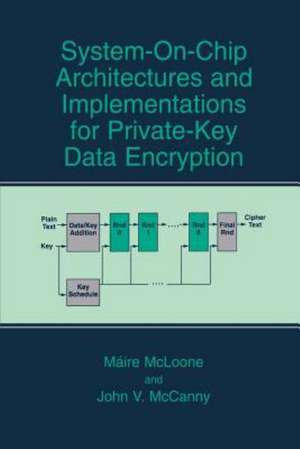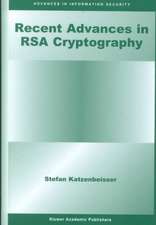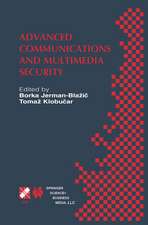System-on-Chip Architectures and Implementations for Private-Key Data Encryption
Autor Máire McLoone, John V. McCannyen Limba Engleză Paperback – 14 sep 2012
In the opinion of the authors, highly efficient hardware implementations of cryptographic algorithms are provided in this book. However, these are not hard-fast solutions. The aim of the book is to provide an excellent guide to the design and development process involved in the translation from encryption algorithm to silicon chip implementation.
| Toate formatele și edițiile | Preț | Express |
|---|---|---|
| Paperback (1) | 634.68 lei 6-8 săpt. | |
| Springer Us – 14 sep 2012 | 634.68 lei 6-8 săpt. | |
| Hardback (1) | 640.06 lei 6-8 săpt. | |
| Springer Us – 31 dec 2003 | 640.06 lei 6-8 săpt. |
Preț: 634.68 lei
Preț vechi: 746.69 lei
-15% Nou
Puncte Express: 952
Preț estimativ în valută:
121.46€ • 131.89$ • 102.03£
121.46€ • 131.89$ • 102.03£
Carte tipărită la comandă
Livrare economică 22 aprilie-06 mai
Preluare comenzi: 021 569.72.76
Specificații
ISBN-13: 9781461348979
ISBN-10: 1461348978
Pagini: 180
Ilustrații: XIV, 160 p.
Dimensiuni: 155 x 235 x 9 mm
Greutate: 0.26 kg
Ediția:Softcover reprint of the original 1st ed. 2003
Editura: Springer Us
Colecția Springer
Locul publicării:New York, NY, United States
ISBN-10: 1461348978
Pagini: 180
Ilustrații: XIV, 160 p.
Dimensiuni: 155 x 235 x 9 mm
Greutate: 0.26 kg
Ediția:Softcover reprint of the original 1st ed. 2003
Editura: Springer Us
Colecția Springer
Locul publicării:New York, NY, United States
Public țintă
ResearchCuprins
1 Background Theory.- 1.1. Introduction.- 1.2. Cryptographic Algorithms.- 1.3. Cryptanalysis.- 1.4. Hardware-Based Cryptographic Implementation.- 1.5. AES Development Effort.- 1.6. Rijndael Algorithm Finite Field Mathematics.- 1.7. Conclusions.- 2 Des Algorithm Architectures and Implementations.- 2.1. Introduction.- 2.2. DES Algorithm Description.- 2.3. DES Modes of Operation.- 2.4. Triple-DES.- 2.5. Review of Previous Work.- 2.6. Generic Parameterisable DES IP Architecture Design.- 2.7. Novel Key Scheduling Method.- 2.8. Conclusions.- 3 Rijndael Architectures and Implementations.- 3.1. Introduction.- 3.2. Rijndael Algorithm Description.- 3.3. Review of Rijndael Hardware Implementations.- 3.4. Design of High Speed Rijndael Encryptor Core.- 3.5. Encryptor/Decryptor Core.- 3.6. Performance Results.- 3.7. Conclusions.- 4 Further Rijndael Algorithm Architectures and Implementations.- 4.1. Introduction.- 4.2. Look-Up Table Based Rijndael Architecture.- 4.3. Rijndael Modes of Operation.- 4.4. Overall Generic AES Architecture.- 4.5. Conclusions.- 5 Hash Algorithms and Security Applications.- 5.1. Introduction.- 5.2. Internet Protocol Security (IPSec).- 5.3. IPSec Authentication Algorithms.- 5.4. IPSec Cryptographic Processor Design.- 5.5. Performance Results.- 5.6. IPSec Cryptographic Processor Use in Other Applications.- 5.7. SHA-384/SHA-512 Processor.- 5.8. Conclusions.- 6 Concluding Summary and Future Work.- 6.1. Concluding Summary.- 6.2. Future work.- Appendix A - Modulo Arithmetic.- Appendix B - DES Algorithm Permutations and S-Boxes.- Appendix C - LUTs Utilised in Rijndael Algorithm.- Appendix D - LUTs in LUT-Based Rijndael Architecture.- Appendix E - SHA-384/SHA-512 Constants.- References.
Recenzii
From the reviews:
"Security has become a very critical issue in the provision of mobile services. The demands for effective and secure communications in wireless networks are especially notable in the electronics area. … This is an easy book to read. It focuses on efficient hardware implementation for private key algorithms. ... From the technical point of view, the book is very good, with enough explanations and solution trade-offs." (IEEE Circuits & Devices Magazine, Vol. 21 (6), 2005)
"Security has become a very critical issue in the provision of mobile services. The demands for effective and secure communications in wireless networks are especially notable in the electronics area. … This is an easy book to read. It focuses on efficient hardware implementation for private key algorithms. ... From the technical point of view, the book is very good, with enough explanations and solution trade-offs." (IEEE Circuits & Devices Magazine, Vol. 21 (6), 2005)








